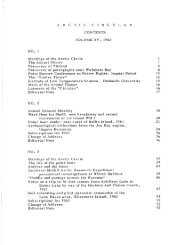Create successful ePaper yourself
Turn your PDF publications into a flip-book with our unique Google optimized e-Paper software.
VOL. XX T}IE ARCTIC CIRCULARt5lliver. Chalcopyrite, bornite, and chalcocite are the principalnetallic minerals and are most abundant t0 to 50 feet above theunconfonnity separating these rocks from the Coppennine RiverGroup. <strong>The</strong> highest assay obtained was A.44 per cent but it ispossible that higher results may be found elser,Ihere and theshowins is an indication that sedimentary copi)er ores may occurin other parts of the post-Coppernine River Group rocks.A preliminary study rvas made of the feasibi lity ofgeochernical surveys as an exploration tool for locating copperdeposits i"n regions of pernafrost. This work was camied outby E.l{.H. Hornbrook and R.J. Allan 42 rniles southwest of thescttlenrent of Coppermine. Preliminary data indicate that thereis active dispersal of Cu from known deposits and that there ismuch potential for the development of geochemical prospectingtechniques in permafrost regions.P.F. l{offman began a study of the Eprvorth Group ofProterozoic sedimentaty rocks in the Coppermine area, Anrongthe ol>jectives of the work is an assessment of the probabilityof occurrence of stratiform copper or lead-zinc rnineralizationof the Mississippi-Valley type and an evalu,ation of the use ofstromatolites for long-range biostratigraphic correlation.Scveral formations which have potential for the occurrence ofbase metal deoosits were outlined.T.N. Irvine carried out a further study of one aspectof the well-knorvn l,luskox Intrusion and has shown that dolomiteand basalt associated with the intrusion are in fact youngeTthan the emplacement of the pluton. Thus it appears that thel{uskox Intrusion is older than the basalt of the CoppermineRiver Group and has no genetic relationship to it.Field studies in Precarnbrian geology were carriedout in other parts of the District of lvlackenzi"e. J.A. Fraserconpleted mapping of Artillery Lake map-area for publicationat a scale of 1:2501000. <strong>The</strong> erea is of interest because ofcurrent prospecting in areas along the <strong>The</strong>lon Front (theboundary lletween the Slave and Churchill structural provinces ofthe Canadian Shield). Ilelicopter traverse.; were supplementedby ground work. <strong>The</strong> northwest corner of the area (within theSlave Province) is underlain by massive muscovite granite; thereniainder is within the Churchill Province and conrprises sneiss,schist, granite, granodiorite, diorite, and gabbro. lulany clairnshavc been staked in the past two years - most lie along thetrend of magnetic anomalie-s which in turn parallel the <strong>The</strong>lonFront












